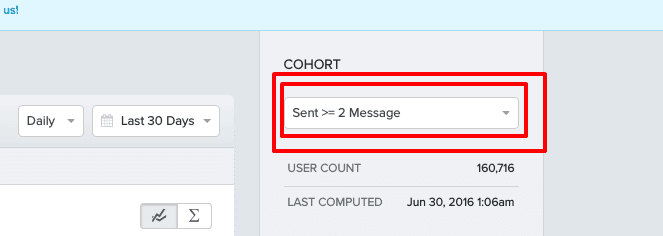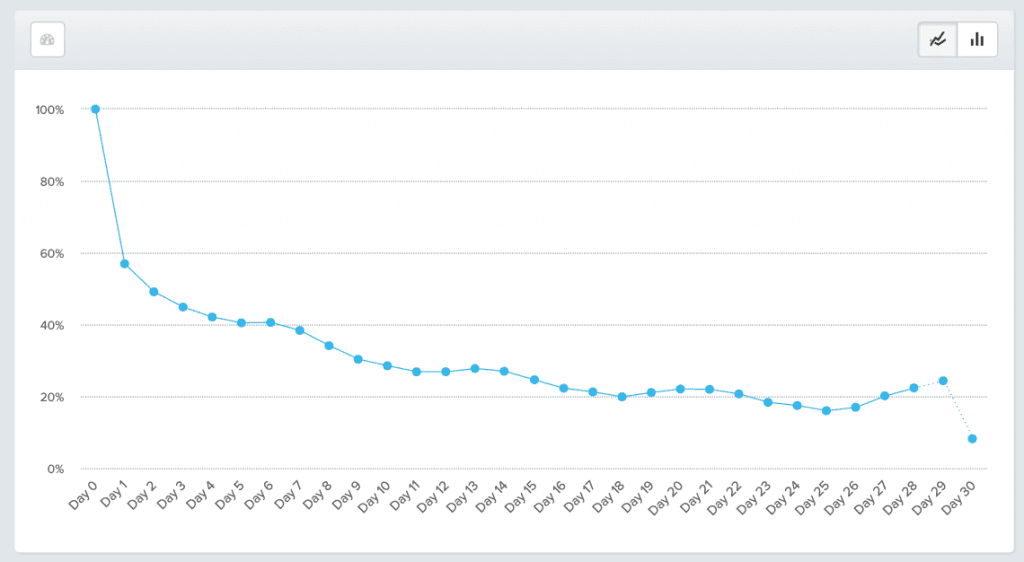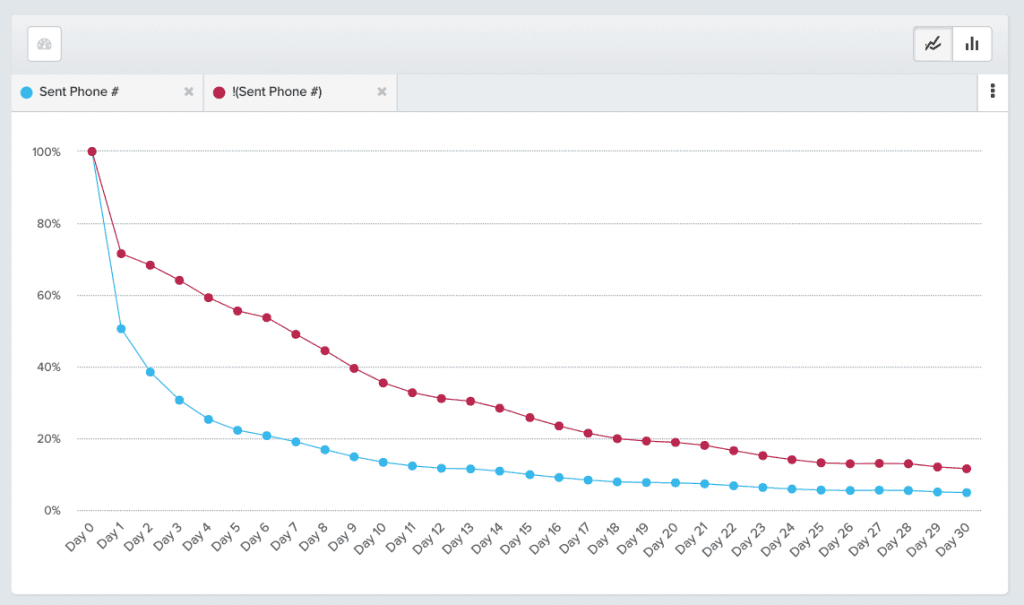Tinder and the Dating App Retention Paradox
Every time Tinder facilitates a successful match and that match leads to a meaningful relationship, they lose two customers.
Tinder is more than the most popular dating app on the market—it’s one of the most powerfully sticky and addictive mobile apps period. Billions of swipes and tens of millions of matches are recorded every single day. Average usage across both male and female users is somewhere around 90 minutes a day.
When it comes to user retention, however, Tinder seems to be caught in a paradox.
Every time Tinder facilitates a successful match and that match leads to a meaningful relationship, they lose two customers.
Ordinarily, apps retain more of their users as they get better. That’s what lets them grow more consistently and build more predictable revenue. For Tinder, it’s the inverse—the better they get at connecting compatible singles, the more users they should lose.
What Tinder shows us is that understanding your retention is more complex than just tracking your active users across the days, weeks, and months that they’re using your app. In Tinder’s case, retention actually has a lot to do with how well users churn.
The Tinder Paradox
Retention is king, of course. According to Bain & Company, it’s 6-7x cheaper to retain existing users than to find new ones. The Harvard Business Review found that even a 5% increase in retention could increase revenues by 25% to 95%. For mobile apps in particular, consistent user engagement is how you build revenue off things like ads and premium services.
Based on that, you might conclude that Tinder has some kind of perverse incentive to make bad matches. They may tease you with the promise of something better, as the thinking goes, but since they’re ultimately going to try to keep you swiping, they’re not going to give it all away at once.
Keeping its users in a perpetual chase sounds like an interesting problem for Tinder’s developers to work on, but it’s actually in embracing this seemingly paradoxical “built-to-churn” model that Tinder’s real opportunities open up.
Good Churn
First, it’s crucial to look at why users are churning.
- People can churn from Tinder and never come back due to the low quality of matches, boredom, technical problems or harassment.
- People can churn because they’re exclusive with someone they met through it, or because they fell in love, or because they got married.
- People can churn because they start dating someone casually—then come back a month later and start swiping all over again.
If you think in terms of the value that Tinder offers its users, the second and third explanations are actually connected to desirable outcomes—they show that Tinder has succeeded in delivering on its core promise of creating connections.
The next step is to look more closely at what happens when users churn out for good reasons and identify the actions that lead to that point.
Find The Good Churn
Any analysis of retention or churn has to consider specific patterns of user behavior.
If you just look at your daily active user/monthly active user count, then you’ll have a barometer of your app’s usage, but you’ll never understand what’s driving it or how to make it better.
What you need to do is to identify the patterns of behavior that lead to users finding value in your app and encourage those. That means if “uploading photos” keeps users engaged, get your users to upload more photos. If “creating playlists” does, then nudge more users to create playlists.
With Tinder, where _churning itself _is a good indicator that people are getting value, you have to look at exactly what leads people to churn.
The Contact Exchange
With behavioral cohorts, you can narrow down your user data and analyze groups of them by specific patterns of behavior. In this case, let’s look at the cohort of Tinder users sending >=2 messages a day:
(Just a quick disclaimer – Tinder doesn’t use Amplitude and the data presented in the graphs and screenshots below are purely hypothetical, but it’ll serve to illustrate my point.)
Then we can examine the Day 0 to Day 30 retention of these particular users:


This is our baseline: about 20% of users are still active after fifteen days, which is about average.
Let’s use a regular expression to split this cohort into two. For one cohort, there must be phone number in one of those messages. It shouldn’t be the only message, of course, nor should it be the last—to weed out all those unsuccessful pick-up attempts. (Source: Regextester)

In the other cohort, we’ll put users who did not exchange contact information with their match. Then we can look at the average 30-day retention for a user _after they exchanged contact info over Tinder, _comparing it to the 30-day retention of users who didn’t:

Ah, the sweet churning of love! Clearly, users who exchange contact information are significantly less likely to stick around with Tinder in the short-term. That’s _because _they’ve unlocked Tinder’s value, and maybe even found love.
The next step would be to take those happy churning people and turn them into a custom cohort for further analysis:
- You could look at user flows to see what kinds of behaviors set them apart.
- You could split them demographically to see whether this activity is more prominent with a particular age group, or location, or profession.
- You could compare their LTV (lifetime value) to a baseline user to see who is more profitable for your company in the long-run.
First off, of course, you’d want to look and see what happens to those contact-information-swapping users in the long-run:

Love can be cruel, and not everyone you meet on Tinder is going to be a good long-term fit, but this graph shows users returning to Tinder week after week regardless. Now that’s retention!
Users consistently come back to apps like Tinder because they don’t _expect _to actually be active all the time. If you date someone you meet on Tinder and it fizzles out after a month, you’re not left with a negative impression of the app. It’s only if you’re on Tinder every single day for months, ironically, that you get discouraged.
We assume that all churn is bad, that your most valuable users are active on a daily basis, but that’s a dangerous way to think when it gets in the way of actually delivering value to your users. If you’re a service like Tinder, then your success actually relies on your users churning out every once in a while.
Churn and Retention: It’s Complicated
Some of Tinder’s churned users will return and some of them won’t.
It’s obvious that you want to avoid churn rooted in a bad experience, but it’s also easy to assume that those who permanently churn because they got into serious, long-term relationships are—while heartwarming—ultimately bad for business.
Nothing could be further from the truth. For an app slowly becoming a fully-fledged alternative to real-life dating for everyone—not just millennials and those out for a quick thrill—having a cohort of “graduated users” in meaningful relationships would be a massive prestige-builder. It would also be a huge shift for Tinder, an app that most associate with casual hookups but which sees itself as something bigger.
“The value we’re giving is so much greater than any of these social apps,” founder and CEO Sean Rad told Fast Company. “The matches made on Tinder can change lives. The Snapchat photo from two hours ago—who gives a f$&k?”
For Tinder to really change lives, become even stickier, and continue to grow, it’s not their user retention that needs attention—it’s how their users churn.

Aditya Vempaty
Former Head of Marketing, Amplitude
As the former head of marketing at Amplitude, he had the privilege of hiring and leading a fantastic team of marketers, designers, and content folks to build a marketing engine that resulted in increasing revenues by 400% in 15 months.
More from Aditya




